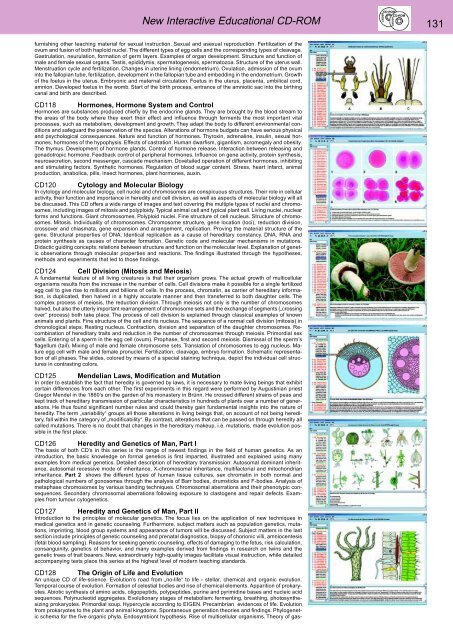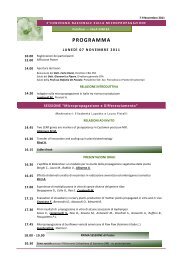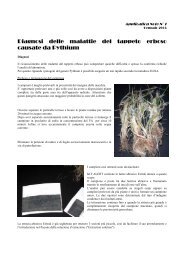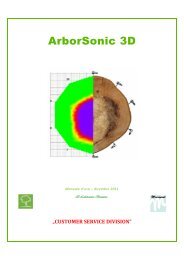BIOLOGY - microscopia.info
BIOLOGY - microscopia.info
BIOLOGY - microscopia.info
You also want an ePaper? Increase the reach of your titles
YUMPU automatically turns print PDFs into web optimized ePapers that Google loves.
New Interactive Educational CD-ROM<br />
131<br />
furnishing other teaching material for sexual instruction. Sexual and asexual reproduction. Fertilization of the<br />
ovum and fusion of both haploid nuclei. The different types of egg cells and the corresponding types of cleavage.<br />
Gastrulation, neurulation, formation of germ layers. Examples of organ development. Structure and function of<br />
male and female sexual organs. Testis, epididymis, spermatogenesis, spermatozoa. Structure of the uterus wall.<br />
Menstruation cycle and fertilization. Changes in uterine lining (endometrium). Ovulation, admission of the ovum<br />
into the fallopian tube, fertilization, development in the fallopian tube and embedding in the endometrium. Growth<br />
of the foetus in the uterus. Embryonic and maternal circulation. Foetus in the uterus, placenta, umbilical cord,<br />
amnion. Developed foetus in the womb. Start of the birth process, entrance of the amniotic sac into the birthing<br />
canal and birth are described.<br />
CD118 Hormones, Hormone System and Control<br />
Hormones are substances produced chiefly by the endocrine glands. They are brought by the blood stream to<br />
the areas of the body where they exert their effect and influence through ferments the most important vital<br />
processes, such as metabolism, development and growth. They adapt the body to different environmental conditions<br />
and safeguard the preservation of the species. Alterations of hormone budgets can have serious physical<br />
and psychological consequences. Nature and function of hormones. Thyroxin, adrenaline, insulin, sexual hormones,<br />
hormones of the hypophysis. Effects of castration. Human dwarfism, gigantism, acromegaly and obesity.<br />
The thymus. Development of hormone glands. Control of hormone release. Interaction between releasing and<br />
gonadotropic hormone. Feedback control of peripheral hormones. Influence on gene activity, protein synthesis,<br />
neurosecretion, second messenger, cascade mechanism. Dovetailed operation of different hormones, inhibiting<br />
and stimulating factors. Synthetic hormones. Regulation of blood sugar content. Stress, heart infarct, animal<br />
production, anabolica, pills, insect hormones, plant hormones, auxin.<br />
CD120 Cytology and Molecular Biology<br />
In cytology and molecular biology, cell nuclei and chromosomes are conspicuous structures. Their role in cellular<br />
activity, their function and importance in heredity and cell division, as well as aspects of molecular biology will all<br />
be discussed. This CD offers a wide range of images and text covering the multiple types of nuclei and chromosomes,<br />
including images of mitosis and polyploidy. Typical animal cell and typical plant cell. Living nuclei, nuclear<br />
forms and functions. Giant chromosomes. Polyploid nuclei. Fine structure of cell nucleus. Structure of chromosomes.<br />
Mitosis. Individuality of chromosomes. Chromosome structure, gene location (loci), reduction division,<br />
crossover and chiasmata, gene expansion and arrangement, replication. Proving the material structure of the<br />
gene. Structural properties of DNA. Identical replication as a cause of hereditary constancy. DNA, RNA and<br />
protein synthesis as causes of character formation. Genetic code and molecular mechanisms in mutations.<br />
Didactic guiding concepts: relations between structure and function on the molecular level. Explanation of genetic<br />
observations through molecular properties and reactions. The findings illustrated through the hypotheses,<br />
methods and experiments that led to those findings.<br />
CD124 Cell Division (Mitosis and Meiosis)<br />
A fundamental feature of all living creatures is that their organism grows. The actual growth of multicellular<br />
organisms results from the increase in the number of cells. Cell divisions make it possible for a single fertilized<br />
egg cell to give rise to millions and billions of cells. In the process, chromatin, as carrier of hereditary <strong>info</strong>rmation,<br />
is duplicated, then halved in a highly accurate manner and then transferred to both daughter cells. The<br />
complex process of meiosis, the reduction division. Through meiosis not only is the number of chromosomes<br />
halved, but also the utterly important rearrangement of chromosome sets and the exchange of segments („crossing<br />
over“ process) both take place. The process of cell division is explained through classical examples of known<br />
animals and plants. Fine structure of the cell and its nucleus. The sequence of a normal cell division (mitosis) in<br />
chronological steps. Resting nucleus. Contraction, division and separation of the daughter chromosomes. Recombination<br />
of hereditary traits and reduction in the number of chromosomes through meiosis. Primordial sex<br />
cells. Entering of a sperm in the egg cell (ovum). Prophase, first and second meiosis. Dismissal of the sperm’s<br />
flagellum (tail). Mixing of male and female chromosome sets. Translation of chromosomes to egg nucleus. Mature<br />
egg cell with male and female pronuclei. Fertilization, cleavage, embryo formation. Schematic representation<br />
of all phases. The slides, colored by means of a special staining technique, depict the individual cell structures<br />
in contrasting colors.<br />
CD125 Mendelian Laws, Modification and Mutation<br />
In order to establish the fact that heredity is governed by laws, it is necessary to mate living beings that exhibit<br />
certain differences from each other. The first experiments in this regard were performed by Augustinian priest<br />
Gregor Mendel in the 1860’s on the garden of his monastery in Brünn. He crossed different strains of peas and<br />
kept track of hereditary transmission of particular characteristics in hundreds of plants over a number of generations.<br />
He thus found significant number rules and could thereby gain fundamental insights into the nature of<br />
heredity. The term „variability“ groups all those alterations in living beings that, on account of not being hereditary,<br />
fall within the category of „modificability“. By contrast, alterations that can be passed on through heredity all<br />
called mutations. There is no doubt that changes in the hereditary makeup, i.e. mutations, made evolution possible<br />
in the first place.<br />
CD126 Heredity and Genetics of Man, Part I<br />
The basis of both CD’s in this series is the range of newest findings in the field of human genetics. As an<br />
introduction, the basic knowledge on formal genetics is first imparted, illustrated and explained using many<br />
examples from medical genetics. Detailed description of hereditary transmission: Autosomal dominant inheritance,<br />
autosomal recessive mode of inheritance, X-chromosomal inheritance, multifactorial and mitochondrian<br />
inheritance. Part 2 shows the different types of human tissue cultures, sex chromatin in both normal and<br />
pathological numbers of gonosomes through the analysis of Barr bodies, drumsticks and F-bodies. Analysis of<br />
metaphase chromosomes by various banding techniques. Chromosomal aberrations and their phenotypic consequences.<br />
Secondary chromosomal aberrations following exposure to clastogens and repair defects. Examples<br />
from tumour cytogenetics.<br />
CD127 Heredity and Genetics of Man, Part II<br />
Introduction to the principles of molecular genetics. The focus lies on the application of new techniques in<br />
medical genetics and in genetic counseling. Furthermore, subject matters such as population genetics, mutations,<br />
imprinting, blood group systems and appearance of tumors will be discussed. Subject matters in the last<br />
section include principles of genetic counseling and prenatal diagnostics, biopsy of chorionic villi, amniocentesis<br />
(fetal blood sampling). Reasons for seeking genetic counseling, effects of damaging to the fetus, risk calculation,<br />
consanguinity, genetics of behavior, and many examples derived from findings in research on twins and the<br />
genetic trees of trait bearers. New, extraordinarily high-quality images facilitate visual instruction, while detailed<br />
accompanying texts place this series at the highest level of modern teaching standards.<br />
CD128 The Origin of Life and Evolution<br />
An unique CD of life-science. Evolution’s road from „no-life“ to life - stellar, chemical and organic evolution.<br />
Temporal course of evolution. Formation of celestial bodies and rise of chemical elements. Apparition of prokaryotes.<br />
Abiotic synthesis of amino acids, oligopeptids, polypeptides, purine and pyrimidine bases and nucleic acid<br />
sequences. Polynucleotid aggregates. Evolutionary stages of metabolism: fermenting, breathing, photosynthesizing<br />
prokaryotes. Primordial soup. Hypercycle according to EIGEN. Precambrian evidences of life. Evolution<br />
from prokaryotes to the plant and animal kingdoms. Spontaneous generation theories and findings. Phylogenetic<br />
schema for the five organic phyla. Endosymbiont hypothesis. Rise of multicellular organisms. Theory of gas-







